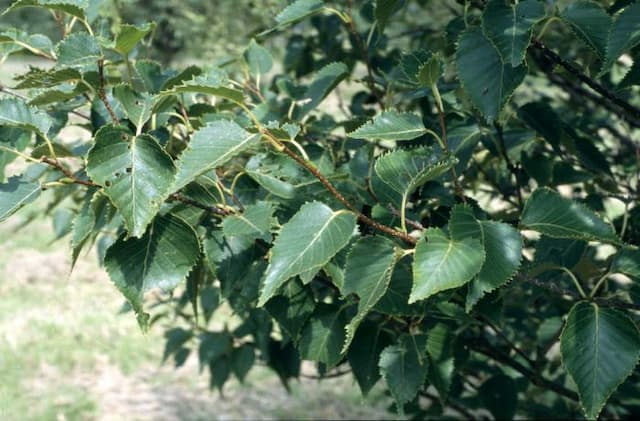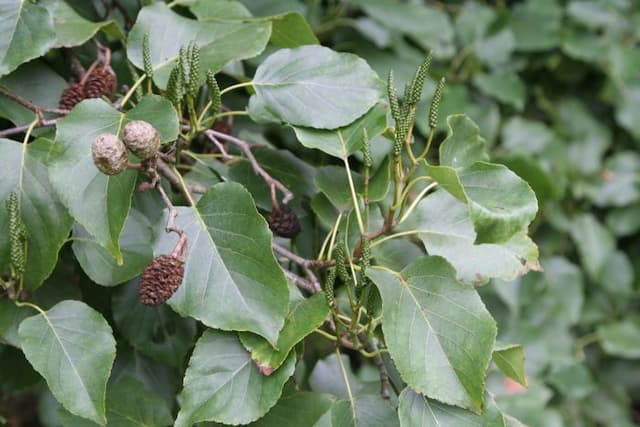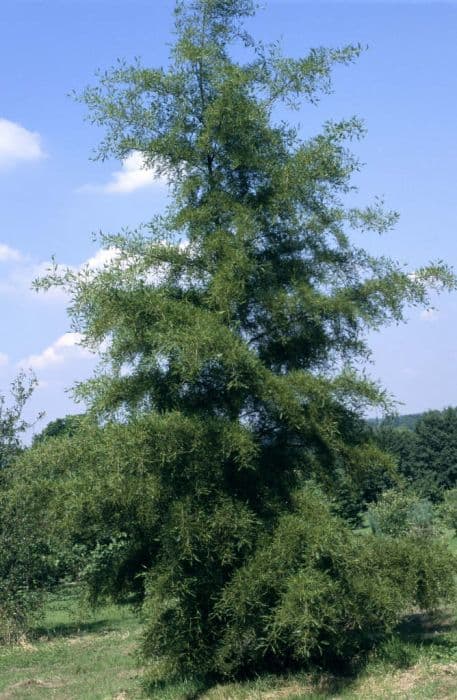Gray Alder Alnus incana

ABOUT
The plant known as gray alder is a species characterized by its smooth, gray bark and a generally slender form. Its leaves are rounded with a pointed tip, featuring serrated margins that give them a somewhat jagged appearance. The leaves display a green color that can turn to a yellowish hue in the autumn season. The gray alder produces both male and female flowers on the same plant, with the male flowers presenting as long, dangling catkins that are typically yellow-brown in color. Female flowers, on the other hand, are much smaller and are grouped into upright, cone-like structures which, after pollination, develop into small, woody cones that persist on the tree through the winter. The branches of the gray alder tend to have a slightly zigzagging pattern, and its twigs may bear a reddish-brown hue, sometimes with a fine, velvety texture when they are young. The overall appearance of the gray alder is one that offers visual interest throughout the year, from its delicate flowers in spring to its leaves in fall and the persistent cones in winter.
About this plant
 Names
NamesFamily
Betulaceae.
Synonyms
Gray Alder, Grey Alder, Speckled Alder, White Alder, Hoary Alder, Mountain Alder, Thinleaf Alder, European Speckled Alder.
Common names
Alnus incana subsp. incana, Alnus incana var. incana, Alnus tenuifolia.
 Toxicity
ToxicityTo humans
Grey alder (Alnus incana) is generally considered non-toxic to humans. There is no widespread evidence to suggest that casual contact or ingestion of parts of the grey alder presents significant toxicological risks to human health. However, like with any plant, individuals may have allergic reactions, and it is always advisable to exercise caution and avoid ingesting plant material that is not commonly recognized as food.
To pets
Grey alder (Alnus incana) is also generally considered non-toxic to pets. There is no common documentation of toxicity in domestic animals, such as cats and dogs, as a result of ingesting parts of the grey alder. Nonetheless, pet owners should monitor their pets and discourage them from eating non-food plants, as individual animals may have different sensitivities or reactions. If any abnormal behavior or symptoms are observed after ingestion, it is advisable to consult a veterinarian.
 Characteristics
CharacteristicsLife cycle
Perennials
Foliage type
Deciduous
Color of leaves
Green
Height
40 feet (12 meters)
Spread
20 feet (6 meters)
Plant type
Tree
Hardiness zones
2
Native area
Europe
Benefits
 General Benefits
General Benefits- Soil enrichment: Alnus incana, commonly known as the grey alder, enhances soil fertility through nitrogen fixation, thanks to the symbiotic relationship with nitrogen-fixing bacteria in its root nodules.
- Erosion control: The root system of grey alders helps stabilize soil and prevent erosion, particularly alongside riverbanks and in wet areas.
- Wildlife habitat: Grey alders provide habitat and food sources for various wildlife species, including birds and insects.
- Timber production: The wood of grey alder is used in the production of furniture, cabinetry, and other woodworking projects due to its lightness and workability.
- Ornamental use: As an attractive deciduous tree, grey alders are sometimes planted for their aesthetic appeal and to add structure to landscaping designs.
- Riparian restoration: Grey alders are often used in riparian restoration projects to help restore natural environments and improve the health of waterways.
 Medical Properties
Medical Properties- Anti-inflammatory: Alnus incana has been used for its potential anti-inflammatory effects.
- Astringent: The bark is known for its astringent properties, which might be used to help in the treatment of various skin disorders.
- Antimicrobial: Extracts from the plant have shown potential antimicrobial activity against certain bacteria and fungi.
- Healing: Due to its astringent and antimicrobial properties, Alnus incana may be traditionally used to promote wound healing.
 Air-purifying Qualities
Air-purifying QualitiesThis plant is not specifically known for air purifying qualities.
 Other Uses
Other Uses- Alnus incana, commonly known as gray alder, has been used in woodworking for creating small household items due to its even texture and moderate hardness, making it easier to work with for intricate designs.
- The bark of gray alder contains tannin and has been historically used for tanning leather, providing the leather with durability and water-resistant properties.
- Gray alder is sometimes planted as a nurse plant in forest restoration projects, where it helps to enrich the soil with nitrogen through its symbiotic relationship with nitrogen-fixing bacteria.
- The wood of gray alder makes an excellent material for producing charcoal that is valued in the arts for drawing and also used for high-quality gunpowder.
- Gray alder has been used in creating musical instruments, particularly woodwind ones like flutes, due to the wood's fine grain and acoustic properties.
- Landscape designers use gray alder in wetland restoration as the plant is tolerant to wet soils and helps in stabilizing stream banks and riparian buffers.
- The flexible young shoots of gray alder have traditionally been used in basketry, woven into intricate patterns for carrying goods and materials.
- Dye extracted from the catkins of gray alder can be used for coloring fabrics in a range of hues from green to yellow, depending on the mordants used.
- In some cultures, the catkins of the gray alder are used for stuffing pillows, as they are soft and can be easily collected during the blooming season.
- The wood of gray alder, when burned, yields an ash rich in potassium, which is helpful as a natural fertilizer in gardens and agricultural fields.
Interesting Facts
 Feng Shui
Feng ShuiThe Grey Alder is not used in Feng Shui practice.
 Zodiac Sign Compitability
Zodiac Sign CompitabilityThe Grey Alder is not used in astrology practice.
 Plant Symbolism
Plant Symbolism- Growth: Alnus incana, commonly known as the Grey Alder, often symbolizes personal growth and development due to its ability to thrive in difficult conditions.
- Resilience: Given its capacity to grow quickly in challenging environments, the Grey Alder signifies resilience and adaptability.
- Protection: In folklore, alders were thought to protect against negative spirits, so the Grey Alder could stand for a spiritual safeguard.
- Pioneering: As a species that often colonizes disturbed areas, the Grey Alder represents pioneering spirit and the first steps in ecological succession.
- Balance: Because alders help to improve the soil quality for other plants, the Grey Alder symbolizes balance and harmony in nature.
 Water
WaterFor the Grey Alder (Alnus incana), watering should be consistent to maintain moist soil conditions, especially when the tree is young and establishing. Newly planted Grey Alders should be watered twice a week, providing about 3 gallons per watering session for each inch of trunk diameter at chest height. Once the tree is established, reduce watering to once a week and adjust for rainfall. During hot and dry spells, supplemental watering may be necessary, ensuring you provide enough water to penetrate the root zone deeply. Avoid overwatering, as Grey Alders do not tolerate waterlogged conditions.
 Light
LightGrey Alders perform optimally in full sun, which means they require at least six hours of direct sunlight each day. They are adaptable to a range of light conditions but will experience the best growth and development with ample sunlight. Plant them in a spot where they are exposed to unfiltered sunlight for the majority of the day.
 Temperature
TemperatureGrey Alders are hardy trees that can withstand a wide temperature range. They can tolerate winter temperatures down to -40 degrees Fahrenheit, and during the growing season, they thrive in temperatures between 50 and 70 degrees Fahrenheit. However, they can survive summer highs well above this range, up to 100 degrees Fahrenheit, without stress if watered properly.
 Pruning
PruningPruning Grey Alders should be done to remove dead or diseased wood, to promote strong structure, and to shape the young tree. The best time to prune Grey Alders is in late winter or early spring before new growth starts. Prune sparingly, focusing only on necessary cuts to minimize stress on the tree, and prune no more than once a year unless safety concerns dictate otherwise.
 Cleaning
CleaningNot needed
 Soil
SoilSpeckled Alder thrives in moist, well-draining soil with a pH of 5.0 to 7.0. A mix of loam, peat, and sand in equal parts can provide the ideal growing conditions.
 Repotting
RepottingSpeckled Alders, being larger trees, do not typically require repotting as they are usually planted outdoors. However, young trees should be planted in their permanent location early on.
 Humidity & Misting
Humidity & MistingSpeckled Alder prefers high humidity environments akin to its natural riparian habitats but is adaptable to a range of atmospheric moisture conditions.
 Suitable locations
Suitable locationsIndoor
Not suitable for indoor growth due to its size.
Outdoor
Plant in moist area, full sun to partial shade, space well.
Hardiness zone
3-7 USDA
 Life cycle
Life cycleGrey alder (Alnus incana) begins its life cycle as a seed, which germinates in the late spring under suitable moisture and temperature conditions. The seedling develops into a juvenile plant with a characteristic alder-like leaf shape and often establishes quickly in its preferred wet or moist environments. As it matures, the grey alder grows into a shrub or small tree, developing a robust root system and a symbiotic relationship with nitrogen-fixing bacteria, which allows it to thrive in poor soils. The plant reaches reproductive maturity within a few years and produces catkins; male catkins are long and pendulous, while female catkins are smaller and upright. After pollination, the female catkins turn into woody cones that contain the seeds. The grey alder completes its life cycle when these seeds are dispersed by wind or water, leading to the establishment of new alder plants.
 Propogation
PropogationPropogation time
Late winter to early spring
The most popular method of propagation for the Alnus incana, commonly known as the Grey Alder, is by seed. This method is usually performed in late winter to early spring. Seeds of the Grey Alder should first be stratified, which involves simulating winter conditions by keeping them cold for a period, typically around 1 to 2 months at about 34-40°F (1-4°C). After stratification, seeds can be sown in pots or trays with well-draining soil and lightly covered with soil. They should be kept moist until germination, which usually occurs within a few weeks. Once the seedlings have grown enough to handle, they can be transplanted outdoors to their final growing location after any danger of frost has passed.









